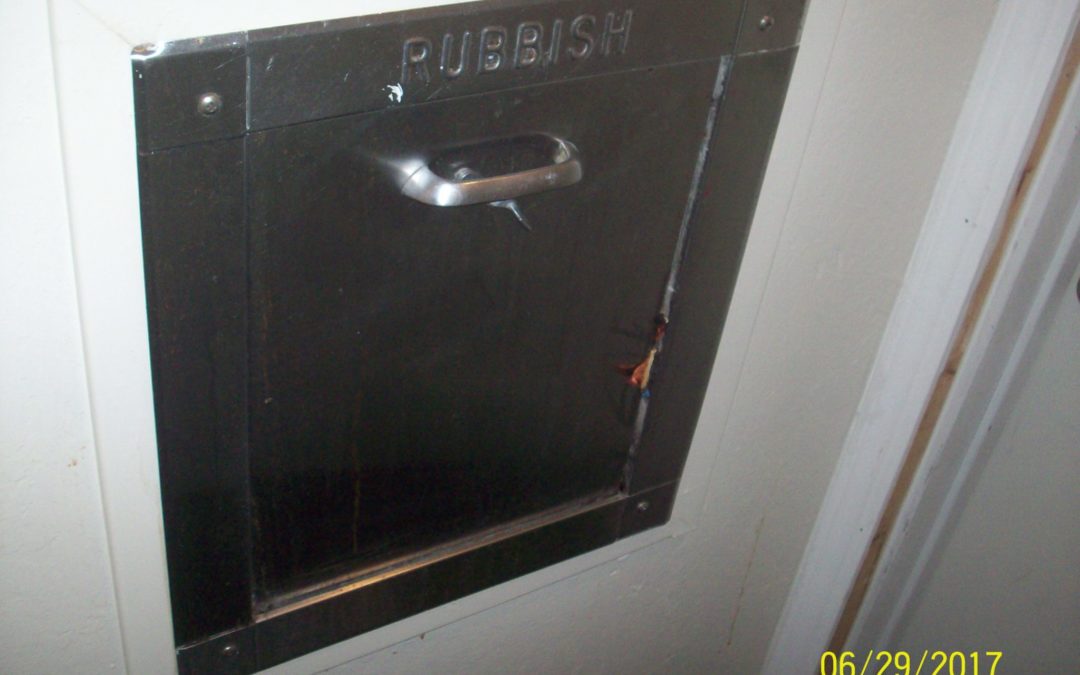Trash Chutes Aren’t Trashy

In many multi-residence buildings such as hotels, condos, and high-rises, trash chutes are fairly commonplace. These make waste disposal convenient and hassle-free for people living on the higher levels, where transporting garbage, bed linens, etc. can pose not only a nuisance but substantial health hazards both to the tenant and the people around them. However, aside from a quick run to the chute to drop waste paper or household garbage, we rarely consider that trash chutes, which often lead to boiler and incinerator rooms, are also the first line of defense against fires!
Typically, the user-facing sections of trash chutes are swinging doors which are designed to be easy to open. On the other side, and at another door at the bottom of the chute, are safety devices called “fusible links.” When a fire is detected, usually through a smoke detector alert, these links “fail” at a prescribed and relatively low temperature, which NFPA 82®, Standard on Incinerators and Waste and Linen Handling Systems and Equipment, specifies as a maximum of 165F, far lower than the combustion point of most materials currently used in residential construction. This code also describes in detail how these links must function, and where they must be placed in order to effectively seal off a laundry or trash chute in case of fire.
A typical fusible-link system for trash chutes usually works like this:
When a smoke detector goes off in a laundry room, trash depository or in the chute itself, indicating a fire, the fusible link breaks. When they do, this closes and secures the chute doors, preventing people from opening them and inadvertently letting smoke or fire into other areas of the building while helping to choke off the fire’s oxygen supply and extinguish it faster. Also, if a fire occurs within the chute itself, there can be a sprinkler head at the top of the chute which sends water down the chute to help put out the blaze. In the meantime, the smoke detector, which can be linked to the building’s main life safety alert system, sounds an alarm to alert the residents to the presence of a fire to let them know to get out of the building.
As a day-to-day part of urban high-rise life, most people rarely give much thought to the incredible amount of care and detail required to build even the most mundane things, such as trash chutes. NFPA 82 lays out what safety mechanisms must be in place for an incinerator room or trash chute to be considered within specifications, as well as referencing additional standards that work with NFPA 82 to optimize safety. Additionally, because of the design of these chutes in buildings where they are located, they form a major element of the building’s fire and life safety system.
If properly maintained, trash and laundry chutes aren’t trashy at all. In fact, they may actually save your building and the lives of the people and pets who reside there! We at Statcomm want to take this opportunity to invite you to reach out to learn more, to find out whether your building’s trash and laundry chutes are up to standards or to have them tested for proper operation and code compliance. You can contact us at (650) 988-9508; or drop by our office at 939-C San Rafael Avenue, Mountain View, California 94043. Fire safety is everyone’s responsibility and at Statcomm, we take a lot of pride in making sure our clients, friends, and neighbors have the peace of mind of knowing their life safety systems will work the way they need to when it really matters!
Check out our other Newsletter articles below…
